TEl: +86-13148388090
Fax:+86-571-88616515
How to Choose the Right Intermittent Catheter
Author: admin / 2025-05-05For individuals who experience urinary retention, neurogenic bladder, or certain urological conditions, intermittent catheterization offers a reliable way to empty the bladder safely and efficiently. Unlike indwelling catheters, intermittent catheters are inserted only when needed and removed after use. This approach reduces the risk of infection and gives patients greater mobility and independence. However, selecting the right intermittent catheter is crucial for comfort, safety, and long-term success.

Why the Right Catheter Matters?
Using an ill-fitting or inappropriate catheter can lead to complications such as urethral trauma, bladder spasms, infection, and discomfort. The right catheter will allow smooth insertion and drainage, minimize irritation, and fit the user's anatomy and lifestyle.
Below are key factors to consider when choosing the right intermittent catheter:
1. Catheter Coating: Coated vs. Uncoated
Intermittent catheters are available in two main types: coated and uncoated.
Uncoated Catheters require the user to apply a water-soluble lubricant or anesthetic gel before insertion. These are often more economical but require more preparation and handling.
Coated Catheters (such as hydrophilic-coated catheters) come pre-lubricated or with a gel/saline packet for activation. They offer a smoother insertion experience, reduce friction, and lower the risk of urethral injury. They are especially beneficial for users with sensitive skin or frequent catheterization needs.
2. Catheter Tip: Straight vs. Coude
Catheters are designed with different tip styles to accommodate anatomical and clinical differences.
Straight Tip catheters are the most common and suitable for most women, and children. They are ideal when there are no obstructions in the urethra.
Coude Tip (curved tip) catheters are designed to navigate around obstructions such as enlarged prostates or urethral strictures. They are often recommended for men who have difficulty with straight-tip catheters.
3. Length of the Catheter
The correct catheter length ensures complete bladder emptying without excessive tubing.
Pediatric Length: 6–12 inches; designed for children's shorter urethras.
Female Length: 6–8 inches; shorter, more discreet, and suitable for women.
Male Length: 16 inches; accommodates the longer male urethra.
Using the wrong length can lead to handling difficulties or incomplete bladder drainage.
4. Catheter Size (Diameter)
Catheter diameter is measured in French units (Fr). Choosing the correct size is important for comfort and flow rate.
Smaller diameters (e.g., 8–10 Fr) are easier to insert but may drain urine more slowly.
Larger diameters (e.g., 14–16 Fr) allow faster drainage but can cause irritation if too large for the urethra.
Your healthcare provider can help you find the ideal size based on your anatomy and condition.
5. Catheter End Type: Funnel vs. Luer
Funnel End catheters have a color-coded hub that corresponds to their French size. This end allows users to connect the catheter to a urine collection bag or easily grip the device without contaminating the tube.
6. Material Options
Different materials suit different needs and sensitivities:
- PVC (Vinyl): Transparent and smooth, vinyl catheters are firm yet slightly flexible. They are often preferred for short-term or occasional use.
- Red Rubber (Latex): Soft and pliable, these catheters warm quickly to body temperature but are not suitable for people with latex allergies.
- Silicone: Flexible and hypoallergenic, silicone catheters are a great option for long-term use and latex-sensitive individuals.
7. Lifestyle Considerations
- Mobility: Active individuals may prefer compact, pre-lubricated options that are easy to carry and use discreetly.
- Dexterity: Users with limited hand mobility may benefit from touch-free catheter systems or those with ergonomic packaging.
- Frequency of Use: Those who catheterize multiple times per day may need more comfort-oriented or lower-friction options to protect their urethral lining.
Conclusion
Choosing the right intermittent catheter is not one-size-fits-all—it's a personal decision that depends on your anatomy, medical needs, and daily routine. Always consult a healthcare professional for guidance before starting or changing your catheter regimen.
With the proper catheter, intermittent catheterization can become a safe, comfortable, and empowering part of your daily life.
About BEVER Medical Intermittent Catheters
BEVER Medical Intermittent Catheters are designed to meet the high standards of clinical performance and patient comfort. Manufactured with premium medical-grade materials, these catheters feature polished eyelets for smooth insertion and optimal drainage. Available in multiple sizes, lengths, and tip options, they are ideal for hospitals, clinics, and distributors seeking reliable, cost-effective solutions for intermittent catheterization. Suitable for both new and long-term users, BEVER catheters ensure consistency, safety, and satisfaction in every use.


